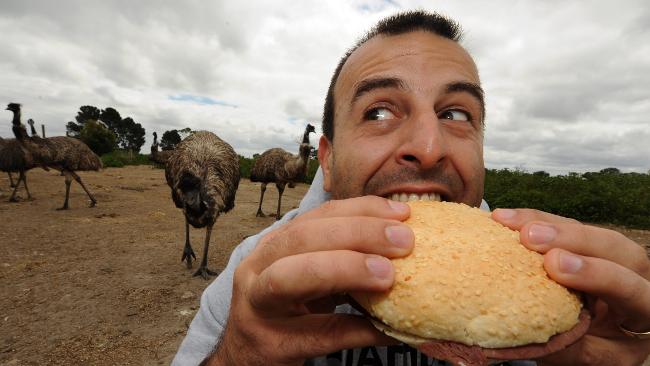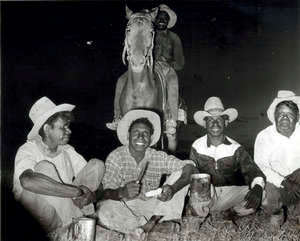Geoffrey Roy Rush (born 6 July 1951) is an Australian actor and film producer. He is one of the few people who has won the
"Triple Crown of Acting": an
Academy Award, a
Tony Award and an
Emmy Award. He has won one Academy Award for acting (from four nominations), three British Academy Film Awards (from five nominations), two Golden Globe Awards and four Screen Actors Guild Awards. He is the foundation President of the Australian Academy of Cinema and Television Arts.
Australian actors, first started appearing in American films a few years ago now, and no one raised much of a fuss. After all, there were only a few of them ( Cate Blanchett, Naomi Watts, etc.). Stars such as Mel Gibson and Nicole Kidman became household names, but even so, their movie accents were so Americanized that many people didn’t know they were foreign. Back then, Australians who came here wanted to blend into the fabric of American society, except maybe Paul Hogan.
Then the flood gates opened in Hollywood, and some very talented Aussie male actors have emerged.
Here are a few you may have heard of !
Eric Bana (42) Born Eric Banadinović on August 9, 1968 in Melbourne, Victoria, Australia to a father of Croatian descent and a German mother. Mostly known for playing Rachel McAdams’ love interest in The Time Traveler’s Wife. His other movies include Black Hawk Down, Finding Nemo,
Hulk, Troy, Munich, The Other Boleyn Girl, Star Trek and Funny People.
In 1995, Bana began dating a publicist and daughter of the chief justice of Australia, Rebecca Gleeson. The couple married in 1997 and now have two children, a son named Klaus – born August 1999, and a daughter named Sophia – born April 2002.
1. His first jobs include washing cars, pushing trolleys and serving drinks at a hotel
2. He loves racing bikes and cars
3. Big fan of Australian rules football
4. Bana began as a stand up comedian
5. His first car was an old 1974 Ford Falcon XB Coupe, purchased for $1000 at age 15
Favorite TV/ Movie appearance: The Time Traveler’s Wife.
Russell Crowe (46) Born Russell Ira Crowe on April 7, 1964 in Wellington, New Zealand and is of Polynesian, English, Scottish and Norwegian descent. Crowe is mostly known for movies like The Quick and the Dead, The Insider,
Gladiator, Proof of Life, Master and commander, Cinderella man, American Gangster, Body of Lies, State of Play and Robin Hood.
While filming The Crossing, Crowe met Australian singer and actress, Danielle Spencer. The couple married on April 7, 2003 (Crowe’s 39th birthday) and now have two sons, Charles born December 21, 2003 and Tennyson born July 7, 2006.
1. Dropped out of high school
2. His favorite toy growing up was Action Man
3. Crowe plans to donate his brain to medical science when he dies
4. When his wife was pregnant with his first child, Crowe gave up drinking alcohol with her
5. In 2007 decided that he finally wanted to be baptised
Favorite TV/ Movie appearance: Master and Commander.
Hugh Jackman (42) born Hugh Michael Jackman on October 12, 1968 in Sydney, New South Wales, Australia to English parents. He is mostly known for the role of
wolverine in X-Men. Some of his other movies include: Swordfish, Kate and Leopold, Van Helsing, The Prestige, Flushed Away, Happy Feet, Real Steel and Australia.
Jackman married Deborra-Lee Furness in 1996 after meeting on an Australian TV show. Furness had two miscarriages after which the couple decided to adopt Oscar Maximilian – born May 15, 2000 and Ava Eliot – born July 10, 2005.
1. As a child he wanted to be a chef on a plane.
2. Jackman is left handed
3. One of his lifelong goals is to play Pharaoh in a Broadway production
4. His stunt double for Van Helsing and X-Men was his brother in law
5. In elementary school, he had a poster of Olivia Newton-John and he kissed the poster every day
Favorite TV/ Movie appearance: Van Helsing.
Simon Baker (41) Born July 30, 1969 in Launceston, Tasmania, Australia. Baker is mostly known for playing Patrick Jane on the CBS drama
The Mentalist but he has also appeared in shows such as L.A. Confidential and The Guardian, as well as movies like The Ring Two, The Devil Wears Prada and The Killer Inside Me.
Baker married Australian actress Rebecca Rigg, they have three children: Stella Breeze – born in 1993, Claude Blue – born in 1998 and Harry Friday – born in 2001. Two of the children’s god parents include Nicole Kidman and Naomi Watts.
1. Became a U.S. citizen in 2010
2. As a teen, Baker competed on a state level in water polo and surfing
3. Used to work as a bricklayer before he became an actor
4. Met his wife on a blind date in 1991
5. Raised Roman Catholic
Favorite TV/ Movie appearance: The Mentalist.
Ryan Kwanten (34) Born Ryan Christian Kwanten on November 28, 1976 in Sydney, New South Wales, Australia and is of Dutch ancestry. Mostly known for playing Sookie’s brother on the HBO vampire drama,
True Blood but he has also appeared in shows like Tru Calling, Summerland and Law & Order: SVU, as well as the movie Flicka and Legend of the Guardians.
Kwanten dated The Event’s Taylor Cole (Vicky Roberts) from 2006-2008 as well a country music singer named Whitney Duncan, who was the fifth place finalist on the fifth season of Nashville Star.
1. In 2010, the Australian GQ magazine named Kwanten as Man of the Year
2. His interests includ triathlon, swimming, tennis, golf, surfing and snow skiing
3. As a teen, he was the state welterweight boxing champ
4. Discovered acting by accident, when he wondered into his brother’s theater audition
5. He attended catholic school
Favorite TV/ Movie appearance: True Blood.
Liam Hemsworth (20) Born January 13, 1990 in Melbourne, Victoria, Australia. Hemsworth is mostly known for playing Will Blakelee in The Last Song, along-side Miley Cyrus. He has also appeared in the Australian TV series Home and Away, McLeod’s Daughters, The Elephant Princess, the movie Knowing and is currently filming
Arabian Nights.
Hemsworth started dating Miley Cyrus after they filmed The Last Song together. The young couple were together for fifteen months, then broke up in August 2010, got back together in September and broke up again by November.
1. Liam was already in a 5 year relationship while filming The Last Song
2. Has two older brothers who are also actors
3. Had a small part in the Expendables but was written out of the script
4. Lost the part of Thor to his brother Chris Hemsworth
5. Went back to Australia to break up with his girlfriend so he can date Miley Cyrus
Favorite TV/ Movie appearance: The Last Song.
Sam Worthington (34) Born Samuel Henry J. Worthington on August 2, 1976 in Godalming, Surrey, England and moved to Perth, Western Australia when he was only two months old. He is mostly known for playing Jake Sully in
Avatar, Marcus Wright in Terminator Salvation and Perseus in Clash of the Titans.
Worthington dated actress Maeve Dermody from 2004 to 2007 and since 2009 he has been dating stylist Natalie Mark. The couple is now keeping a low profile, living in New York.
1. Sold all his possessions for $2,000 when he was 30
2. Lived in his car until getting the part in Avatar
3. Was a finalist to play James Bond in Casino Royale before Daniel Craig was cast
4. Just like Simon Baker, he was a bricklayer before becoming an actor
5. Sam has blurred vision but does not wear glasses
Favorite TV/ Movie appearance: Avatar.
Julian McMahon Born Julian Dana William McMahon on July 27, 1968 in Sydney, New South Wales, Australia. Mostly known for playing the role of Christian Troy in
Nip/Tuck and Cole Turner in Charmed. His movies include Fantastic Four, Premonition and Fantastic Four: Rise of the Silver Surfer.
McMahon married Kylie Minouge’s little sister, Dannii Minogue in 1994 and divorced by 1995. In 1999 he married actress Brooke Burns, had one child with her and divorced in 2002.
1. McMahon enjoys surfing, biking, and cooking
2. Collects classic books
3. Has worked as gardener and ice cream salesman
4. His favorite beer is Aussie Victoria Bitter VB
5. Favorite song is “People are Strange” by The Doors
Favorite TV/ Movie appearance: Charmed.
Alex O’Loughlin (34) Born Alexander O’Lachlan on August 24, 1976 in Canberra, Australia. He is mostly known for playing detective Steve McGarrett in
Hawaii Five-O. Other shows include The Shield and Moonlight, as well as the movies Whiteout with Kate Beckinsale and The Back Up Plan with Jennifer Lopez.
Had a son named Saxon when he was 20 that currently lives with his mother in Australia. O’Loughlin also dated Australian Actress, model and singer Holly Valance, who released the international single “Kiss, Kiss”.
Fun Facts:
1. Enjoys riding motorcycles, rock climbing and playing his guitar
2. Was a fan of the heavy-metal band Iron Maiden as a kid
3. His parents got divorced when he was two years old
4. Is of Irish and Scottish descent
5. Is a big fan of vampires
Favorite TV/ Movie appearance: Hawaii Five-O.
Chris Hemsworth (born 11 August 1983) is an Australian actor. Most notable for protraying Thor in the Marvel Studios film Thor. Hemsworth is set to reprise his role as Thor in the upcoming films The Avengers in 2012 and Thor 2 in 2013. He also starred as Kim Hyde in the Australian soap opera Home and Away.
His older brother Luke and younger brother Liam are also actors, and have had recurring roles as Nathan Tyson and Josh Taylor on Neighbours, respectively






















































